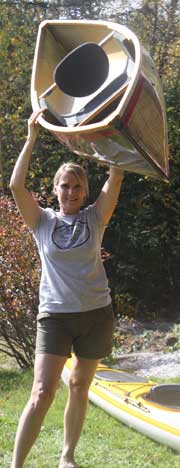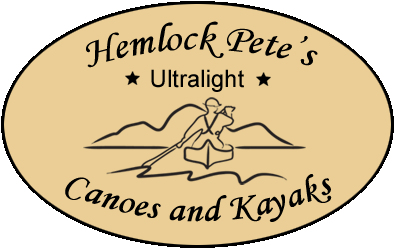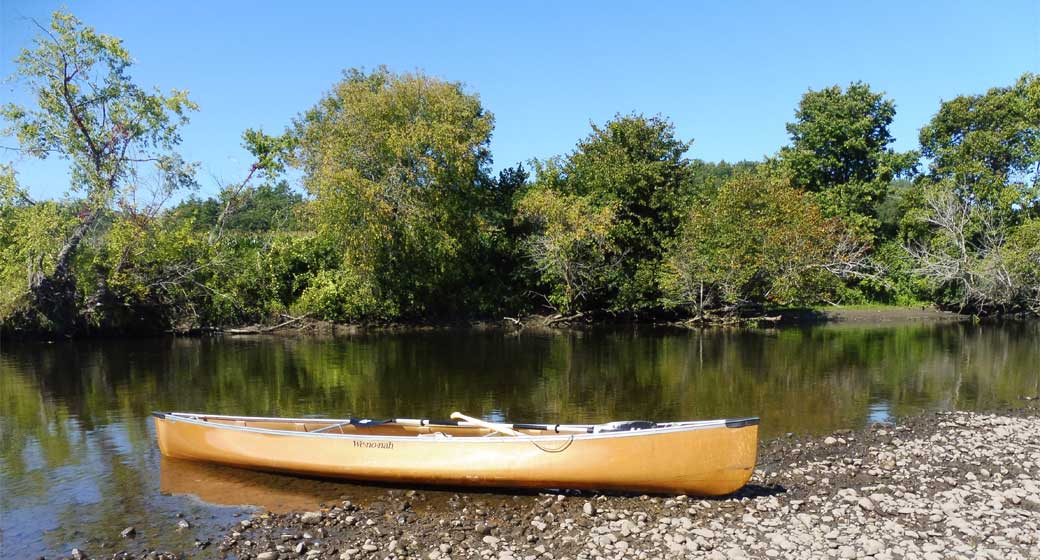




![]() Ultralight boats!
Ultralight boats!
Hull Materials
Today's canoes are constructed from a variety of materials. The ultimate canoe would be light, durable, virtually maintenance free, and inexpensive. Life should be so simple. While modern technology has given us an ultra light, durable, maintenance free hull, it unfortunately in not low cost.
Lets take a look at some of the materials being used today and how canoes are constructed with them.
Wood/canvas construction experienced a decline in demand after WWII with the advent of aluminum and fiberglass canoes. Recently however its popularity seems to be growing. Of all the canoes I have paddled in my life nothing quite compares to the smooth, quiet glide of a wood/canvas hull. Steaming and bending ribs over a form that looks like an upside down canoe make the hull. Thin planking is then tacked to the ribs lengthwise along the hull. Cedar is generally the wood of choice here. A sheet of canvass is attached over the planking and painted. Trim is installed then everything is varnished. These canoes are quite expensive usually $2000 and up. They tend to be a bit heavy, a 16" model being in the 70 lb range. Compared with modern materials they are not very rugged and will require considerable upkeep.
Aluminum is a popular material for a number of reasons and is equally unpopular for others. It makes a very rugged canoe, which requires no maintenance. The price is reasonable (not cheap) and they are readily available. However they are noisy, even the smallest wave slapping the side will announce your presence for a good distance. Hull shapes are limited, as it does not lend itself to sharp bends and curves gracefully. They are generally heavy and if you do severely damage one they are difficult to repair.
Plastics, I call these Tupperware boats. I am referring to royalex and polyethelene.
Royalex is a plastic foam sandwich made by Uniroyal. Its composition varies a bit for each individual canoe manufacturer, some even give it fancy names, but the base material is the same regardless of who builds the canoe. The hull is made by heating a sheet of material and stretching it over a mold. Once cooled, trim is attached and presto, you have a canoe. The material is expensive putting the cost of a canoe at +/- $900. It is extremely rugged bouncing off rocks, trees, bridges, and even highways with little or no damage. General maintenance is minimal. Royalex is bulky and relatively heavy. It does not lend itself well to fine lines and sharp curves. A common problem with it is oil "canning". The material is not very stiff and the canoe bottom tends to flex up and down in the water. This does not hurt the canoe at all, and in rough rocky water absorbs a lot of punishment, however the flexing does affect the performance of the canoe as it moves through the water. The material has been around for over 25 yrs. Since its introduction to the canoe market many improvements have been made in reducing weight, mold ability, and stiffness. Several of today's manufacturers are turning out hulls under 60lbs with nice lines and drastically reduced oil canning.
Polyethylene has basically the same characteristics as royalex except for the price, which is much lower, and weights, which are a bit higher. There are a couple of different types of polyethylene and the different manufacturers have strong opinions in support of their respective choices. The hull is formed by either melting or pressing plastic into a mold. Once cooled, add seats, etc. and presto you have a canoe.
Composites:
Fiberglass, Kevlar, Spectra, and Carbon Fiber are wonderful materials to build a canoe with. When done correctly it produces a light, durable hull that requires minimal upkeep. Price varies with the material, as does the weight. It also can be molded into very complex shapes and is easy to repair. You must be cautious though making sure proper materials are used and that they are formed the correct way as construction quality can vary greatly. All composite boats use a cloth or fiber and a resin to give it stiffness. An opaque resin paint mixture called a gel coat is generally applied to the outside of the canoe for color and to protect the cloth from abrasion and UV rays. The key to a composite hull is the ratio of resin to cloth. You want only enough resin to wet and harden the cloth, no more. Excess resin makes a heavy and brittle hull.
One method of construction known as chopper-gun utilizes chopped up fiberglass fibers. Here short random fibers are mixed with resin and blown together into a mold. The result is a heavy, brittle canoe that carries a low price tag. Another way to produce a low cost canoe is to use a hand lay-up. Again, fiberglass is the material of choice as the goal is to produce a low cost boat. Woven roving, which is a heavy weight coarse cloth, is laid in the mold and resin is spread over it by hand. This weave of cloth requires substantial resin to saturate it and therefore produces a heavy hull although not as brittle as the chopper-gun method.
The ultimate composite lay-up utilizes a fine weave cloth combined with a vacuum bagging process. In this process a precise amount of resin is poured into the mold on top of the cloth. Then a vinyl a bag is put over the mold and a strong vacuum drawn, which squeezes all of the air spaces out and evenly spreads the resin where it is needed. The result is the lowest resin to cloth ratio possible. This provides a light, strong, stiff, and resilient hull. Composite canoes are certainly not as rugged as aluminum, royalex, or polyethylene. They are however more than adequate for all but the most severe conditions.
Fiberglass: As far as composites go, this is used generally to produce low cost canoes. The advantages over plastic are refined lines, reduced weight, and equal or lower cost. Construction method is generally chopper-gun or hand-laid woven roving. Occasionally you will find a vacuum bagged lay-up. It will be expensive as the vacuum bagging process is very labor intensive.
Dupont Kevlar 49: This is another synthetic cloth that works well in canoe construction. The weave looks similar to fiberglass except that it has a very distinctive yellow color and it is half the weight of fiberglass and a bit stronger. Construction is done almost exclusively with the vacuum bagging process. The results are a canoe that is 25% lighter than its fiberglass cousin. The only drawback is price, $1500 and up.
Spectra/Carbon Fiber: If your wallet has no bottom then we can
get into some of the higher-level materials. Spectra is a relatively new
material that has come out and is even lighter and stronger than Kevlar.
Carbon fiber is another. Generally these materials are used in combination
with each other taking advantage of their specific qualities to form the
lightest strongest canoes available. Construction techniques are difficult
and only a handful of manufacturers offer them, generally only in racing
designs. The prices are high, $2000 and up.
Until next time, HAPPY PADDLING!!!

Have a question? I'm happy to answer it - just email me at hpcanoes@gmail.com
![]()
hpcanoes@gmail.com
603.667.5112

We specialize in ultralight solutions and offer expertise in canoes and Wee Lassie boats, as well as all the related equipment. Our favorites are Wenonah canoes and Wee Lassie boats. Although we will work with any material we like to get folks set up with lightweight canoes so you can dedicate your time to the joy of being out on the lakes and rivers instead of struggling to move your boat between car and water.
Scott Edwards, "Hemlock Pete" himself, offers you decades of paddling expertise. He is friendly, down-to-earth, and provides superior customer service. You won't find a better, or more pleasant, deal elsewhere.

